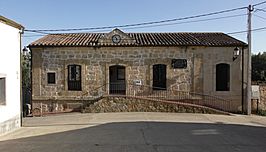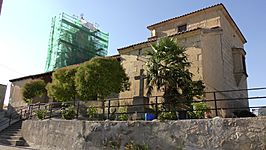Cuelgamures facts for kids
Quick facts for kids
Cuelgamures
|
|
|---|---|
|
Top down: City Hall, España Street and church of Santa María Magdalena.
|
|
| Country | |
| Autonomous community | |
| Province | |
| Municipality | Cuelgamures |
| Area | |
| • Total | 14 km2 (5 sq mi) |
| Population
(2018)
|
|
| • Total | 86 |
| • Density | 6.14/km2 (15.9/sq mi) |
| Time zone | UTC+1 (CET) |
| • Summer (DST) | UTC+2 (CEST) |
Cuelgamures is a very small village, also known as a municipality, located in Spain. It is found in the province of Zamora, which is part of the larger region called Castile and León. As of 2019, only about 85 people lived there, making it a very quiet and peaceful place.
Contents
Discovering Cuelgamures
Cuelgamures is a charming municipality in northwestern Spain. It's a great example of a small Spanish village. Life here is often calm and connected to nature.
Where is Cuelgamures?
Cuelgamures is located in the province of Zamora. A province is like a county or a smaller area within a larger region. Zamora province is known for its beautiful landscapes and historic towns.
The region where Cuelgamures is located is called Castile and León. This is one of Spain's 17 "autonomous communities." These communities are like states or large self-governing areas within the country.
What is a Municipality?
In Spain, a municipality is a local administrative area. It's like a town or a small district. Each municipality has its own local government, often led by a mayor. This government helps manage local services for the people living there.
Cuelgamures is one of many municipalities in the province of Zamora. Even though it's small, it plays an important role in the local area.
Life in Cuelgamures
With a population of around 85 people, Cuelgamures is one of the smallest municipalities in Spain. This means everyone likely knows each other. Life in such a small community can be very close-knit.
The main building in the village is often the town hall (Ayuntamiento). This is where local decisions are made. The church, like the Church of Santa María Magdalena, is also a central part of village life and history.
See also
 In Spanish: Cuelgamures para niños
In Spanish: Cuelgamures para niños




